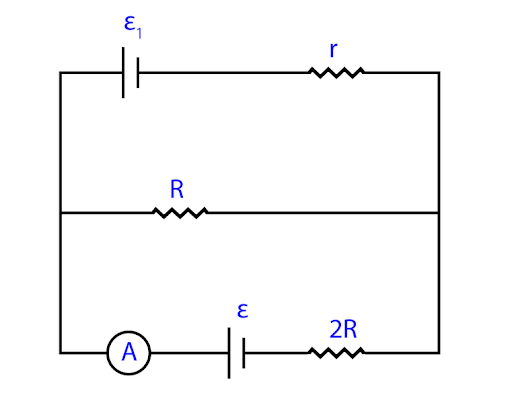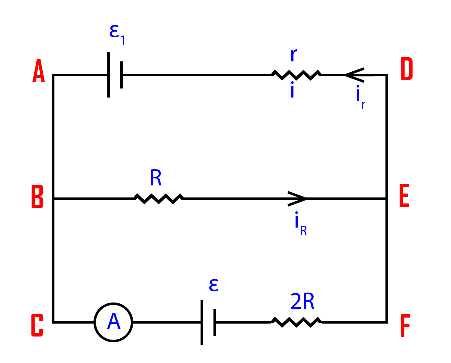
The incorrect option in the given circuit if the reading of ammeter is zero is

A. The value of
B. Current in R is
C. Value of
D. Potential across 2R is zero.
Answer
190.5k+ views
Hint: The question is from the current electricity section of physics. We need to have basic knowledge of concepts like resistance, current, potential difference to solve this problem.
Formula used:
Equation of the current is given as,
Where,
Complete step by step solution:
The ammeter reading is zero, so the current will only flow in the upper circuit. The circuit diagram is shown below.

Equation of the current,
Here the current will be,
The potential difference between the points:
Also the potential difference between the points A and D:
Substituting the value or
Option (A) is correct. The value of
Option (B) is correct. Current in R (
Option (D) is correct. Potential across 2R is zero. Because no current is flowing through 2R.
Option (C) is incorrect. Value of
Hence, the correct option is option C.
Additional Information: The difference in charge carriers' energy between two places in a circuit is known as the potential difference. Due to the potential difference between the two ends of the battery, current will flow through a wire if its two ends are connected to the opposite ends of the same battery.
Resistance blocks the flow of current. The S.I. unit of resistance is ohms. The current decreases as resistance increases. On the other hand, the current increases as the resistance decreases. A conductor's electrical resistance is affected by the following parameters: The conductor's cross-sectional area, the conductor's length, the conductor's material and the conducting material's temperature. Electrical resistance is inversely proportional to the cross-sectional area and directly proportional to the conductor's length.
Note: In this type of problem, most of the students make mistakes in taking the direction of flow of current through the battery. Always that current must flow from positive terminal to negative terminal if the battery.
Formula used:
Equation of the current is given as,
Where,
Complete step by step solution:
The ammeter reading is zero, so the current will only flow in the upper circuit. The circuit diagram is shown below.

Equation of the current,
Here the current will be,
The potential difference between the points:
Also the potential difference between the points A and D:
Substituting the value or
Option (A) is correct. The value of
Option (B) is correct. Current in R (
Option (D) is correct. Potential across 2R is zero. Because no current is flowing through 2R.
Option (C) is incorrect. Value of
Hence, the correct option is option C.
Additional Information: The difference in charge carriers' energy between two places in a circuit is known as the potential difference. Due to the potential difference between the two ends of the battery, current will flow through a wire if its two ends are connected to the opposite ends of the same battery.
Resistance blocks the flow of current. The S.I. unit of resistance is ohms. The current decreases as resistance increases. On the other hand, the current increases as the resistance decreases. A conductor's electrical resistance is affected by the following parameters: The conductor's cross-sectional area, the conductor's length, the conductor's material and the conducting material's temperature. Electrical resistance is inversely proportional to the cross-sectional area and directly proportional to the conductor's length.
Note: In this type of problem, most of the students make mistakes in taking the direction of flow of current through the battery. Always that current must flow from positive terminal to negative terminal if the battery.
Recently Updated Pages
Mass vs Weight: Key Differences, Units & Examples Explained

Uniform Acceleration: Definition, Equations & Graphs for JEE/NEET

Area of an Octagon Formula - Explanation, and FAQs

Difference Between Vapor and Gas: JEE Main 2026

Carbon Dioxide Formula - Definition, Uses and FAQs

Absolute Pressure Formula - Explanation, and FAQs

Trending doubts
JEE Main 2025 Session 2: Application Form (Out), Exam Dates (Released), Eligibility, & More

Equation of Trajectory in Projectile Motion: Derivation & Proof

Atomic Structure: Definition, Models, and Examples

Angle of Deviation in a Prism – Formula, Diagram & Applications

Hybridisation in Chemistry – Concept, Types & Applications

Collision: Meaning, Types & Examples in Physics

Other Pages
JEE Advanced Marks vs Ranks 2025: Understanding Category-wise Qualifying Marks and Previous Year Cut-offs

Wheatstone Bridge Explained: Principle, Working, and Uses

How to Convert a Galvanometer into an Ammeter or Voltmeter

JEE Advanced Weightage 2025 Chapter-Wise for Physics, Maths and Chemistry

Average and RMS Value in Physics: Formula, Comparison & Application

Elastic Collisions in One Dimension: Concepts, Derivation, and Examples




